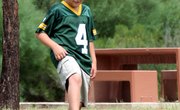Study after study has found that sports benefits children in many ways; athletics keep kids fit and can help them perform better academically. Unfortunately, some kids can miss out due to school budget cuts that clip athletics programs and sports facilities. To help schools out, numerous organizations offer grants just for schools sports facilities.
Finding Providers
Providers of school sports facility grants include major sporting corporations like Major League Baseball, which offers baseball facilities grants through its Baseball Tomorrow Fund. The Easton Sports Foundation provides grants for archery-related facilities. School districts can check with local governments and nonprofits to see if any offer facility grants. In the state of Washington, for example, King County sponsors a Youth Sports Facilities Grant for its schools. In Oregon, the Oregon Sports Authority provides grants for schools in that state. Other providers include major sports foundations like the U.S. Soccer Foundation, which has given grant money to schools throughout the country for soccer facility improvements.
Application Process
To help a school determine if it is eligible for a certain grant program, some providers offer an online eligibility survey or ask the school to submit a letter of inquiry describing their sport facility needs. Along with the application, schools must turn in other paperwork such as tax documents proving tax-exempt status, annual budget reports, and letters of support from matching fund donors or other major donors. Additionally, the grant provider may ask for detailed reports on a proposed facility project including its budget, timeline and cost estimates.
Using the Money
Some providers will demand grant recipients use the money in specific ways. That could mean grants based on the sport, gender, minorities or grade levels. The Charlotte Martin Foundation grant program, for example, wants to support projects that specifically help girls ages 6 to 18. Some providers may ask the school to match its funds either with a certain percentage of the cost or dollar for dollar. For example, United States Tennis Association's facilities grants require the recipient to secure matching funds equal to at least 50 percent of the grant amount. The provider may also specify the money can't go toward certain expenses such as loan payments, overhead costs and land purchases.
Following Through
The grant amounts vary greatly from provider to provider. Some offer the money upfront, while others reimburse the school as the project goes along. After completing the project, the grant recipient may have to submit one or more reports on how the money was spent and specific outcomes such as an increase in participation. The U.S. Soccer Foundation's Safe Places to Play grant program requires grant recipients to turn in before and after pictures from the project, as well as a community impact report. Applicants can check on the status for their application by contacting the grant provider directly through phone call or email.
Related Articles
References
Writer Bio
Lindsey Thompson began her writing career in 2001. Her work has been published in the Cincinnati Art Museum's "Member Magazine" and "The Ohio Journalist." You'll also find her work on websites like Airbnb, Chron.com, and USAToday.com. Thompson holds a Bachelor of Science in journalism from the Scripps School of Journalism at Ohio University.











